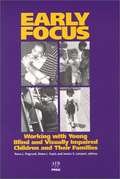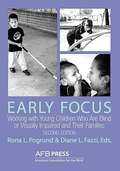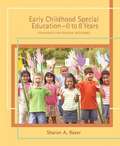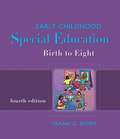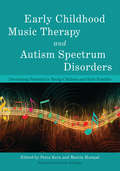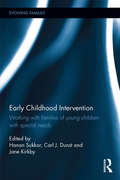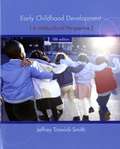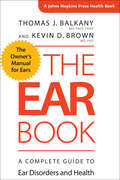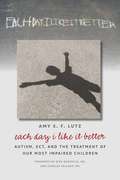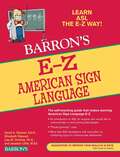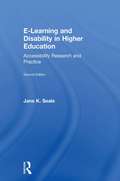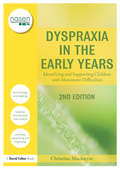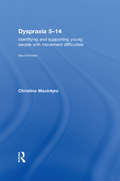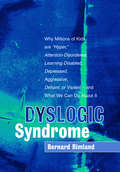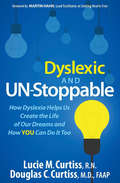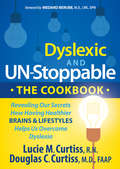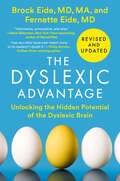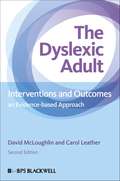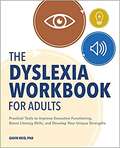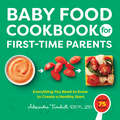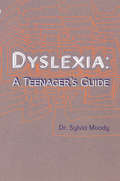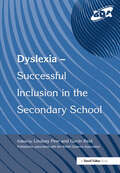- Table View
- List View
Early Focus: Working With Young Blind or Visually Impaired Children and Their Families
by Jessica S. Lambert Diane L. Fazzi Rona L. PogrundStressing the importance of early intervention in working with children with visual impairment, Pogrund (formerly special education, California State U.) and Fazzi (special education, California State U.) offer practitioners (teachers and other specialized professionals) an edited guide to working with children under age five. Eleven chapters review the developmental areas that are likely to be affected by vision loss and discuss the theory and knowledge base behind suggested educational practices in these areas. Chapters cover working with families, medical and functional implications, cognitive development, literacy, social development, promotion of independence and daily living skills, behavioral supports, motor and mobility development, and working with other professionals. Annotation (c)2003 Book News, Inc., Portland, OR (booknews.com)
Early Focus: Working with Young Children Who Are Blind or Visually Impaired and Their Families (Second Edition)
by Rona L. Pogrund Diane L. FazziThe second edition of Early Focus: Working With Young Children Who Are Blind or Visually Impaired and Their Families is a comprehensive resource on early childhood visual impairment. It addresses the needs of children who are blind or visually impaired from the age of birth to 5.
Early Childhood Special Education (0 to 8 Years): Strategies for Positive Outcomes
by Sharon A. RaverFeaturing the application of evidence-based strategies, ecological and family-based approaches, effective learning, and the use of responsive cultural/linguistic practices, Early Childhood Education (0-8 Years): Strategies for Positive Outcomes, prepares students for all the professional knowledge and skill competencies they need to promote optimal development in infant and toddlers (0-3), preschoolers (3-5), and primary-aged (6-8) children with special needs. Using real-life case studies to illustrate recommended practices, the book clearly presents disability characteristics, assessment practices, and easy-to-implement interventions for inclusive and special education settings, while giving students all the resources they need to master and apply the material. Highlights of This First Edition: Prepares students with ALL the professional knowledge and skill competencies necessary to promote optimal development in children with special needs from birth through 8 years old. Highlights intervention techniques from special education, speech-language pathology, occupational/physical therapy, and the fields of vision and hearing impairments. Uses a real-life case study in each chapter to illustrate recommended practices and strategies. Examines the legal, philosophical, and instructional tenets of the field of Early Childhood Special Education in detail, including IDEA 2004. Features how to use evidence-based practices and strategies that maximize communicative, cognitive/literacy, fine and gross motor, adaptive, and social-emotional development in infants and toddlers, preschoolers, and primary-aged children.
Early Childhood Special Education: Birth to Eight
by Frank G. BoweEarly Childhood Special Education: Birth to Eight is now available in the 4th edition. The 4th edition expands coverage of pre-academics and academics, responding to No Child Left Behind and IDEA 2004. The five key areas of development: communication, physical, cognitive, social/emotional, and adaptive, all include updated coverage. This is the only text on the market that addresses all of early childhood, age birth through eight, and all of early childhood special education. The text also takes into consideration that early childhood special education is a field driven by federal law, and contains complete coverage of those laws. Each chapter has opening questions, ending questions, and activities to help the student learn and retain the information. There is a full chapter devoted to research, and an online companion that serves to supplement the text and offers up to the minute content updates. The student will appreciate the outstanding readability of this updated, authoritative text.
Early Childhood Music Therapy and Autism Spectrum Disorders
by Marcia Humpal Edited by Petra KernThis comprehensive book includes an overview of recent developments in ASD and effective music therapy interventions based on ASD-specific approaches, instructional strategies and techniques for use in children's natural environments. Therapists wishing to conduct family-centered practice and to support parents integrate music into home routines will find a wealth of information, together with insights from music therapists who are parents of children with ASD. The book also looks at collaboration and consultation with interdisciplinary team members, including early childhood educators, speech-language pathologists and occupational therapists. Case scenarios, examples, checklists, charts, tip sheets, music scores, and online resources make this book accessible for everyone. Throughout the book's sixteen chapters, renowned experts share knowledge and practical applications that will give music therapists, students, professionals, educators, families and anyone interested in working with young children with ASD, a detailed understanding of the implementation and range of music therapy practices that can benefit these children and their families.
Early Childhood Intervention: Working with Families of Young Children with Special Needs (Evolving Families)
by Hanan Sukkar Carl J. Dunst Jane KirkbyEarly childhood is considered a critical but often vulnerable period in a child’s development where early identification and intervention can be crucial for improving children’s developmental outcomes. Systems and family-centred perspectives are vital to support families and build their capacities to lead normalized lives with improved family quality of life. This book explores the family-centred practices and systems factors which influence families’ experiences raising children with complex needs. It also considers the ways in which professionals can work with families to build and support parent and child competence. Conceptual and practical work from Australia, Canada, Europe and the United States present descriptions of and implications for different family system frameworks and early-childhood programs. Contributors in this edited volume bring together contemporary information that bridges the research to practice gap in supporting families of young children with disabilities or delays. Chapters include: Early Intervention for Young Children with Developmental Delays: Contributions of the Developmental Systems Approach Family Composition and Family Needs in Australia: What Makes a Family? Working with Families in Early Childhood Intervention: Family-Centred Practices in an Individualised Funding Landscape Family Systems and Family-Centred Intervention Practices in Portugal and Spain: Iberian Reflections on Early Childhood Intervention This book will attract the attention scholars of Parenting and Families; Child Development and Childcare.
Early Childhood Development: A Multicultural Perspective
by Jeffrey W. Trawick-SmithEarly Childhood Development: A Multicultural Perspective, Fifth Edition addresses both typical and atypical child development from birth through age eight. This text highlights the diversity of child development, preparing professionals to meet the unique needs of children from a wide variety of backgrounds.
The Ear Book: A Complete Guide to Ear Disorders and Health (A Johns Hopkins Press Health)
by Thomas J. Balkany Kevin D. Brown“Everything you ever wanted to know about ears from two outstanding physician scientists. I loved this book!” —Donna Shalala, Former U.S. Secretary of Health and Human ServicesIn The Ear Book, Drs. Thomas J. Balkany and Kevin D. Brown, recognized experts on ears and hearing, explain how the anatomy of the ear facilitates hearing and balance and then examine the causes, symptoms, and treatment of common problems of the outer, middle, and inner ear. Their explanations take the mystery out of hearing aids, the proper care of ears, and how the pressurized conditions of scuba diving and air travel affect the ears. And they debunk ear-related myths—from the notion that exposure to loud noise strengthens the ear to the idea that tinnitus can be cured with nutrients—and urge readers to stop using ear candling or Q-tips to get rid of wax.Drs. Balkany and Brown address such common questions as: Can dizziness be cured? How loud is too loud? Why do my ears ring? Do cochlear implants work for nerve deafness? What promise do innovations in gene therapy and stem cell therapy hold for the future? Fully illustrated and including helpful tables, hearing preservation tips, a glossary of terms, lists of ear medications and resources, and suggestions for further reading, The Ear Book is sure to be a welcome family guide.“This book is gem for everyone with questions about their ears. I highly recommend it—especially the chapter on Myths of the Ear!” —D. Bradley Welling, MD, PhD, Harvard University Department of Otolaryngology
Eagles Don't Eat Worms
by Linda Kudlik Jack WeylandJeff steals a guide dog to earn a reward. He is caught, and for two months he must live as a blind person. He learns a lot about himself and others around him In addition the police officer falls in love with the blind woman. This is Morman fiction.
Each Day I Like It Better: Autism, ECT, and the Treatment of Our Most Impaired Children
by Amy LutzIn the fall of 2009, Amy Lutz and her husband, Andy, struggled with one of the worst decisions parents could possibly face: whether they could safely keep their autistic ten-year-old son, Jonah, at home any longer. Multiple medication trials, a long procession of behavior modification strategies, and even an almost year-long hospitalization had all failed to control his violent rages. Desperate to stop the attacks that endangered family members, caregivers, and even Jonah himself, Amy and Andy decided to try the controversial procedure of electroconvulsive therapy or ECT. Over the last three years, Jonah has received 136 treatments. His aggression has greatly diminished, and for the first time Jonah, now fourteen, is moving to a less restricted school. Each Day I Like It Better recounts the journeys of Jonah and seven other children and their families (interviewed by the author) in their quests for appropriate educational placements and therapeutic interventions. The author describes their varied, but mostly successful, experiences with ECT. A survey of research on pediatric ECT is incorporated into the narrative, and a foreword by child psychiatrist Dirk Dhossche and ECT researcher and practitioner Charles Kellner explains how ECT works, the side effects patients may experience, and its current use in the treatment of autism, catatonia, and violent behavior in children.
Each Day I Like It Better: Autism, ECT, and the Treatment of Our Most Impaired Children
by Amy S. LutzIn the fall of 2009, Amy Lutz and her husband, Andy, struggled with one of the worst decisions parents could possibly face: whether they could safely keep their autistic ten-year-old son, Jonah, at home any longer. Multiple medication trials, a long procession of behavior modification strategies, and even an almost year-long hospitalization had all failed to control his violent rages. Desperate to stop the attacks that endangered family members, caregivers, and even Jonah himself, Amy and Andy decided to try the controversial procedure of electroconvulsive therapy or ECT. Over the last three years, Jonah has received 136 treatments. His aggression has greatly diminished, and for the first time Jonah, now fourteen, is moving to a less restricted school. Each Day I Like It Better recounts the journeys of Jonah and seven other children and their families (interviewed by the author) in their quests for appropriate educational placements and therapeutic interventions. The author describes their varied, but mostly successful, experiences with ECT. A survey of research on pediatric ECT is incorporated into the narrative, and a foreword by child psychiatrist Dirk Dhossche and ECT researcher and practitioner Charles Kellner explains how ECT works, the side effects patients may experience, and its current use in the treatment of autism, catatonia, and violent behavior in children.
E-Z American Sign Language, 3rd Edition (Barron's E-Z Series)
by David Stewart Elizabeth Stewart Lisa DimlingA Simon & Schuster eBook. Simon & Schuster has a great book for every reader.
E-Learning and Disability in Higher Education: Accessibility Research and Practice
by Jane K. SealeMost people working within the higher education sector understand the importance of making e-learning accessible to students with disabilities, yet it is not always clear exactly how this should be accomplished. E-Learning and Disability in Higher Education evaluates current accessibility practice and critiques the extent to which 'best' practices can be confidently identified and disseminated. This second edition has been fully updated and includes a focus on research that seeks to give 'voice' to disabled students in a way that provides an indispensible insight into their relationship with technologies and the institutions in which they study. Examining the social, educational, and political background behind making online learning accessible in higher and further education, E-Learning and Disability in Higher Education considers the roles and perspectives of the key stake-holders involved in e-learning: lecturers, professors, instructional designers, learning technologists, student support services, staff developers, and senior managers and administrators.
e-Accessibility Policy Handbook for Persons with Disabilities
by Nirmita NarasimhanBased on the ITU-G3ict e-Accessibility Policy Toolkit for Persons with Diabilities
Dyspraxia in the Early Years: Identifying and Supporting Children with Movement Difficulties (nasen spotlight)
by Christine MacintyreToday there are more children than ever before in need of a variety of additional support needs, and many of these children have poor movement as a key contributory factor. Even in children with no specific ‘label’, movement is being found to be linked to learning, and educational professionals need to understand what is amiss and how to support children who do not meet their motor milestones at the correct time. The brand new topic areas featured in this comprehensive and practical new edition include: a discussion of terminology and labelling (in light of current inclusion guidelines) a range of age specific activities a section on the neurology of dyspraxia, showing the motor pathways that are energised and define motor competence a greater emphasis on balance, coordination and control examples from children of how movement is dependent on planning, sequencing and organising more practical activities that can form the basis of a programme to support the children. Practical strategies are provided throughout this authoritative book, so that teachers and other professionals can identify and understand movement difficulties, are empowered to support the children, and work effectively with the parents.
Dyspraxia 5-14: Identifying and Supporting Young People with Movement Difficulties (nasen spotlight)
by Christine MacintyreDyspraxia is increasingly common in young children. This fully revised and updated edition of Christine Macintyre’s invaluable companion explains the difficulties faced by children with dyspraxia in growing up and offers suggestions as to how these might be alleviated. In this book the children themselves, along with their parents and teachers, talk about how the difficulties change as the transition is made from primary to secondary school. Children with dyspraxia are frequently beset by frustrations as a result of their differences, can be misunderstood both at home and at school, and are very often bullied. This practical guide considers: the issue of giving children labels strategies to reduce stress the value of movement programmes raising self-esteem the transition to secondary school particular challenges faced during Puberty/adolescence handwriting as an indicator of dyspraxia. Including practical activities with additional material for secondary pupils this book shows children how to articulate their differences using individualised explanations, and then go on to succeed having recognised where their talents lie. Dyspraxia 5-14 is essential reading for teachers, parents, SENCos, teaching assistants and trainee teachers who want to improve their understanding of dyspraxia and its implications for children in Key stages 1-3.
Dyslogic Syndrome: Why Millions of Kids are "Hyper," Attention-Disordered, Learning Disabled, Depressed, Aggressive, Defiant, or Violent - and What We Can Do About It
by Bernard RimlandDyslogical children are commonly labelled as having one or more of a mix of conditions that include Attention Deficit/Hyperactivity Disorder, Conduct Disorder, Bipolar Disorder and Oppositional Defiant Disorder. The number of children who could be described as dyslogical continues to rise sharply, and society has a tendency to lay the blame for this trend on poor parenting or bad schooling. In this ground-breaking book, Bernard Rimland argues that such `conventional wisdom' is not just mistaken but dangerous. Drawing on the latest research, Rimland outlines the impact of biological factors on today's children and exposes the influences of toxins and dietary deficiencies. Dyslogic Syndrome is full of valuable advice on the safe, effective treatments that are available to children, and offers positive strategies for helping parents and professionals to do the best for their dyslogical child.
Dyslexic and Un-Stoppable: How Dyslexia Helps Us Create the Life of Our Dreams and How You Can Do It Too
by Lucie M. Curtiss Douglas C. CurtissDoes your child have difficulty with reading? Is your child's teacher complaining about behavior or attention issues? Is writing a chore for your child? Could your child be dyslexic? You are in luck. "Dyslexic AND UN-Stoppable" is not just another book about dyslexia. It is uniquely designed for both the dyslexic and non-dyslexic reader. "Dyslexic AND UN-Stoppable" shows you how Lucie Curtiss, discovered her own dyslexia at age 25, developed tools and strategies to become a successful entrepreneur. She honed these tools as she helped her dyslexic son excel at school. She then enrolled her husband, Dr. Douglas Curtiss, a Yale-trained pediatrician, to contribute to this book. Together they show you how to implement these strategies in your life so that your dyslexic child can be UN-Stoppable. Youll find practical insights, real-life success stories, and online video tutorials to help your dyslexic child with reading, writing, spelling, math, and much more. And if you are dyslexic yourself, "Dyslexic and UN-Stoppable" will Inspire and Empower you to live the life of your dreams by: - Revealing the True Gifts dyslexia offers - Describing two real-life Success Stories from a mother and a son with dyslexia - Visually teaching you Tools and Strategies you can use every day - Helping you blast through the limitations of dyslexia by Discovering Your Niche - Showing you how to Navigate the School System step by step - Reinstilling your natural Love of Learning Another word for dyslexia is smart. So use these powerful strategies, discover your unique talents, and become UN-Stoppable!,
Dyslexic and Un-Stoppable: Revealing Our Secrets How Having Healthier Brains & Lifestyles Helps Us Overcome Dyslexia
by Lucie M. Curtiss Douglas C. Curtiss Medard BerubeDyslexic and Un-Stoppable The Cookbook: Revealing Our Secrets How Having Healthier Brains and Lifestyles Helps Us Overcome Dyslexia, shares nutritional facts and healthier recipes Lucie and Dr. Doug Curtiss have incorporated in their daily routine. Dyslexic and Un-Stoppable The Cookbook complements Dyslexic AND UN-Stoppable: How Dyslexia Helps Us Create the Life of Our Dreams and How YOU Can Do It Too!, by identifying healthy, beneficial ingredients to improve the odds of overcoming dyslexia. Lucie M. Curtiss, RN, and Dr. Douglas C. Curtiss, FAAP, are the cofounders of Dyslexic AND UN-Stoppable, LLC. Their mission is to empower dyslexic children to become UN-Stoppable and overcome dyslexia by rediscovering their inner power. They are here to remind dyslexics that they are SMART!
The Dyslexic Advantage (Revised and Updated): Unlocking the Hidden Potential of the Dyslexic Brain
by Brock L. Eide Fernette F. EideAn updated edition of Drs. Brock and Fernette Eide's popular dyslexia book with a wealth of new material and improved dyslexic-friendly font. What if we viewed dyslexia as a learning and processing style rather than as a learning disorder? Drs. Brock and Fernette Eide use their impressive backgrounds in neurology and education to debunk the standard deficit-based approach to dyslexia. People typically define &“dyslexia&” as a reading and spelling disorder. But through published research studies, clinical observations, and interviews with dyslexic individuals, the Eides prove that these challenges are not dyslexia&’s main features but are instead trade-offs resulting from an entirely different pattern of brain organization and information processing that has powerful advantages. For example, dyslexic adults routinely outperform their non-dyslexic peers in studies on three-dimensional spatial reasoning and divergent creativity—one of the reasons why so many dyslexics are successful engineers. Approximately 20 percent of the U.S. population has dyslexia, and The Dyslexic Advantage shows how each one is predisposed to powerful skills called MIND strengths (Material, Interconnected, Narrative, and Dynamic Reasoning), leading them to possess incredible pattern detection, divergent thinking, episodic memory, problem solving, and prediction abilities. The revised and updated edition of The Dyslexic Advantage includes eighteen rich new profiles of remarkable individuals with dyslexia—such as several world-renowned scientists, a Pulitzer Prize–winning poet, a world-record-setting memory specialist, three MacArthur &“Genius&” Award winners, the technical advisor for the Jurassic Park movies, and many more. Meanwhile, the enormous advances in dyslexia research over the last ten years provide valuable new insights for educators, employers, parents, dyslexic adults, and anyone interested in neurodiversity and human cognition. Blending personal stories with hard science, The Dyslexic Advantage (Revised and Updated) provides empowering advice on how to identify, understand, nurture, and enjoy the strengths of the dyslexic mind.
The Dyslexic Adult
by Carol Leather David McloughlinA definitive and evidence-based guide for psychologists, teachers, coaches, HR personnel and all professionals who must understand and work with dyslexic adults.The only book to look at dyslexia within the context of life span developmental psychology, including the factors that contribute to success - now fully revised and updatedCombines an accessible style with a strong focus on evidence-based practice and a sound theoretical model on which to base assessment, counselling, teaching and trainingProvides a clear guide to the kinds of assessment that can be conducted and the ways in which dyslexic adults can be supported in selection, training, education and employmentIncludes coverage of overlapping syndromes such as dyspraxia and dyscalculia, and up-to-date check lists for syndromes that can be used as part of the assessment process
The Dyslexia Workbook for Adults: Practical Tools to Improve Executive Functioning, Boost Literacy Skills, and Develop Your Unique Strengths
by Gavin ReidImprove your skills and discover the strengths of your dyslexia―strategies and exercises for adults <P><P> Dyslexia is a continuous, lifelong journey―one that asks you to adapt and grow every day. The Dyslexia Workbook for Adults offers practical tools, techniques, and activities to help you improve your literacy skills, boost your self-esteem, and use your dyslexia as an advantage. <P><P> Gain a sense of empowerment and a greater appreciation for the positive aspects of dyslexia with exercises designed to develop the strengths unique to dyslexic patterns of thinking. Explore specific strategies for targeting problems that adults with dyslexia experience with spelling, reading, writing, memorization, organization, and other executive functioning skills. You’ll come to see your dyslexia as a gift and an important part of you. <P><P> The Dyslexia Workbook for Adults includes: Intro to dyslexia―Learn more about dyslexia and how it impacts adults, and take an assessment of your own experience with the characteristics of dyslexia. Coping strategies―Build resilience to dyslexia-specific stressors in your personal life and the workplace with actionable coping techniques. Dyslexia in action―Read real-life scenarios that depict people with dyslexia using a variety of strategies and employing their strengths to overcome challenges and thrive. Build greater confidence and stronger literacy skills with evidence-based tools and exercises for adults with dyslexia.
Dyslexia Tools Workbook for Teens: 120 Exercises to Improve Reading Skills (Learn to Read for Kids with Dyslexia)
by Jenn Clark Gavin ReidBoost confidence and reading skills with dyslexia tools for teens Reading comprehension is a crucial skill for students to practice, especially students with dyslexia. The Dyslexia Workbook for Teens provides practice and encouragement for kids ages 12 to 16, with 125 activities that focus on learning big words, prefixes and suffixes, word recognition, language fluency, and more. The dyslexia tools in this book support teens as they: Learn independently—Teens can comfortably practice whenever and however they prefer with this collection of dyslexia tools they can work on by themselves. Explore a range of exercises—Keep students interested with word charts, puzzles, fill-in-the-blanks, and other fun activities. Build self-assurance—As teens get better and faster at these exercises, they'll see for themselves how much they're capable of and feel more confident in their reading and language skills. Help middle and high school students in overcoming dyslexia with this book of skill-boosting activities.
Dyslexia: A Teenager's Guide
by Sylvia MoodyDyslexic teenagers face special problems - this book will help solve them. Dyslexia, involving problems with reading, writing, spelling, memory, organisation and time management, can affect people of all backgrounds and abilities. But most books on this subject are geared towards young children; advice for teenagers is thin on the ground. Yet dyslexic teenagers face special problems. They need to master complex study skills, deal with large amounts of revision, and cope with the demands of examinations. They may suffer from stress, anxiety and lack of confidence. Dyslexia: A Teenager's Guide helps young adults tackle these problems with strategies uniquely suited to their needs. Clearly and simply written by a leading expert in the field, the book helps with reading, writing, spelling and memory, as well as giving tips on how to take notes, organise study, deal with examinations and use IT. It also shows how to improve confidence, deal with stress, and build on the creative talent that many dyslexics possess.
Dyslexia-Successful Inclusion in the Secondary School
by David BlunkettIncreasingly dyslexia is becoming a whole-school issue. The responsibility for addressing the needs of dyslexic students no longer rests with one individual but is the responsibility of all school staff - subject specialists and school management. This timely book addresses this need by providing specific guidance to secondary school staff on how to support dyslexic students within different subject areas and within the principles and practices of inclusion.
